 W
WGibbons are apes in the family Hylobatidae. The family historically contained one genus, but now is split into four extant genera and 18 species. Gibbons live in subtropical and tropical rainforest from eastern Bangladesh to Northeast India to southern China and Indonesia.
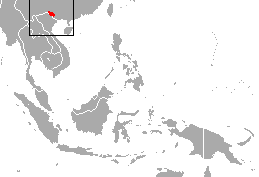 W
WThe eastern black crested gibbon, also known as the Cao-vit black crested gibbon or the Cao-vit crested gibbon, is a species of gibbon from southeast China and northern Vietnam.
 W
WThe black crested gibbon is an endangered species of gibbon found in China, Laos, and northern Vietnam, with four subspecies.
 W
WThe lar gibbon, also known as the white-handed gibbon, is an endangered primate in the gibbon family, Hylobatidae. It is one of the better-known gibbons and is often kept in captivity.
 W
WThe pileated gibbon is a primate in the gibbon family, Hylobatidae.
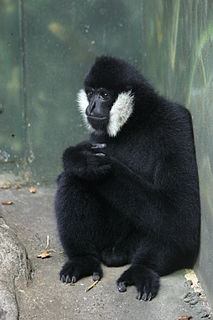 W
WThe northern white-cheeked gibbon is a species of gibbon native to South East Asia. It is closely related to the southern white-cheeked gibbon, with which it was previously considered conspecific. The females of the two species are virtually indistinguishable in appearance.
 W
WThe southern white-cheeked gibbon is a species of gibbon native to Vietnam and Laos. It is closely related to the northern white-cheeked gibbon and the yellow-cheeked gibbon ; it has previously been identified as a subspecies of each of these.
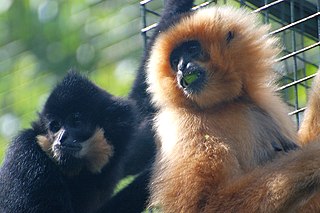 W
WThe yellow-cheeked gibbon, also called the golden-cheeked gibbon, yellow-cheeked crested gibbon, the golden-cheeked crested gibbon, red-cheeked gibbon, or the buffed-cheeked gibbon, is a species of gibbon native to Vietnam, Laos, and Cambodia.. The species was discovered and named after the British naturalist Gabrielle Maud Vassal.
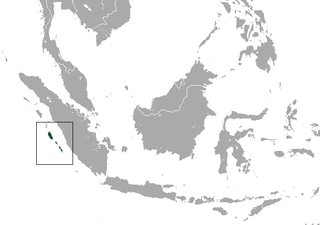 W
WThe pig-tailed langur, monotypic in genus Simias, is a large Old World monkey, endemic to several small islands off the coast of Sumatra in Indonesia. Its face is black, its fur is blackish-brown and it has a relatively short tail. It is a diurnal species, feeding in small groups in the rainforest canopy on leaves, and to a lesser extent, fruit and berries. Little is known of its natural history, but it is heavily hunted, its populations have been declining rapidly and the International Union for Conservation of Nature has assessed its conservation status as being "critically endangered". It has been included on a list of the World's 25 Most Endangered Primates.
 W
WThe Delacour's langur, or Delacour's lutung, is a critically endangered species of lutung endemic to northern Vietnam. It is considered to be one of the world's most endangered primate species. It is named for French-American ornithologist Jean Théodore Delacour.
 W
WGermain's langur is a lutung native to Thailand, Burma, Cambodia, Laos and Vietnam. The Old World monkey was previously included in Trachypithecus cristatus and Trachypithecus villosus.
 W
WThe Hatinh langur is a highly threatened Old World monkey found in limestone forests in Vietnam, primarily in the Quảng Bình Province. A recent survey discovered a small population living in the Quảng Trị Province. Contrary to its name, it is not known from the Hà Tĩnh Province. The local Van Kieu minority refer to this lutung as the 'Con Cung', which roughly translates as "black, cliff-dwelling monkey with a long tail". It resembles the closely related François' langur, but its white cheek-stripes typically extend behind the ears onto the nape, and the overall black colour is non-glossy and has a brownish tinge.
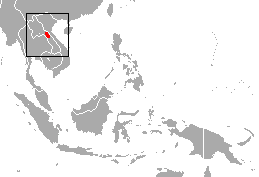 W
WThe Laotian langur or white-browed black langur is a species of primate in the family Cercopithecidae. It is endemic to Laos. Its natural habitat is subtropical or tropical dry forests. Genetically the Indochinese black and Hatinh langurs are very close to the Laotian langur, and consequently it has been suggested they should be considered subspecies of it.
 W
WThe Shortridge's langur is a lutung native to Burma and China.
 W
WThe white-headed langur is a critically endangered langur. Two subspecies are recognized: T. p. poliocephalus in Cát Bà Island, Vietnam, and T. p. leucocephalus in Guangxi, China. The former, often known as the golden-headed or Cat Ba langur, is among the rarest primates in the world, and possibly the rarest primate in Asia, with population size estimated at less than 70 individuals.
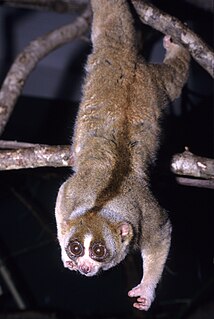 W
WSlow lorises are a group of several species of nocturnal strepsirrhine primates that make up the genus Nycticebus. Found in Southeast Asia and bordering areas, they range from Bangladesh and Northeast India in the west to the Sulu Archipelago in the Philippines in the east, and from Yunnan province in China in the north to the island of Java in the south. Although many previous classifications recognized as few as a single all-inclusive species, there are now at least eight that are considered valid: the Sunda slow loris (N. coucang), Bengal slow loris (N. bengalensis), pygmy slow loris (N. pygmaeus), Javan slow loris (N. javanicus), Philippine slow loris (N. menagensis), Bangka slow loris (N. bancanus), Bornean slow loris (N. borneanus), and Kayan River slow loris (N. kayan). The group's closest relatives are the slender lorises of southern India and Sri Lanka. Their next closest relatives are the African lorisids, the pottos, false pottos, and angwantibos. They are less closely related to the remaining lorisoids, and more distantly to the lemurs of Madagascar. Their evolutionary history is uncertain since their fossil record is patchy and molecular clock studies have given inconsistent results.
 W
WThe silvery lutung, also known as the silvered leaf monkey or the silvery langur, is an Old World monkey. It is arboreal, living in coastal, mangrove, and riverine forests in Peninsular Malaysia, Sumatra, and Borneo.
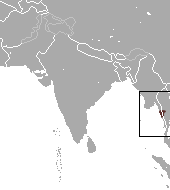 W
WThe Tenasserim lutung is a species of lutung. It is found in Myanmar and Thailand.
 W
WThe crab-eating macaque, also known as the long-tailed macaque, is a cercopithecine primate native to Southeast Asia. It is referred to as the cynomolgus monkey in laboratories. It has a long history alongside humans; it has been alternately seen as an agricultural pest, sacred animal in some temples, and more recently, the subject of medical experiments.
 W
WThe Nicobar long-tailed macaque is a subspecies of the crab-eating macaque, endemic to the Nicobar Islands in the Bay of Bengal. This primate is found on three of the Nicobar Islands—Great Nicobar, Little Nicobar and Katchal—in biome regions consisting of tropical and subtropical moist broadleaf forests.
 W
WThe northern pig-tailed macaque is a species of macaque in the family Cercopithecidae. It is found in Bangladesh, Cambodia, China, India, Laos, Myanmar, Thailand, and Vietnam. Traditionally, M. leonina was considered a subspecies of the southern pig-tailed macaque, but is now classified as individual species.
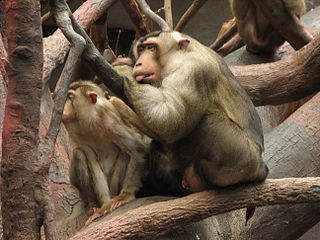 W
WThe southern pig-tailed macaque, also known as the Sundaland pig-tailed macaque and Sunda pig-tailed macaque, is a medium-sized macaque that lives in southern Thailand, Malaysia, and Indonesia. It is known locally as the beruk.
 W
WThe stump-tailed macaque, also called the bear macaque, is a species of macaque found in South Asia. In India, it is found in south of the Brahmaputra River, in the northeastern part of the country. Its range in India extends from Assam and Meghalaya to eastern Arunachal Pradesh, Nagaland, Manipur, Mizoram and Tripura.
 W
WThe proboscis monkey or long-nosed monkey, known as the bekantan in Indonesia, is an arboreal Old World monkey with an unusually large nose, a reddish-brown skin color and a long tail. It is endemic to the southeast Asian island of Borneo and is found mostly in mangrove forests and on the coastal areas of the island.
 W
WThe dusky leaf monkey, spectacled langur, or spectacled leaf monkey is a species of primate in the family Cercopithecidae. It is found in peninsular Malaysia, Myanmar and Thailand; however, dusky leaf monkeys have occasionally been observed in Singapore. It is not clear whether these monkeys are escaped pets or whether they swam to Singapore on their own volition from Johor, Malaysia.
 W
WPhayre's leaf monkey, also known as Phayre's langur, is a species of lutung native to Southeast Asia, including India, Bangladesh, Myanmar, Thailand, Laos, Vietnam, and China. It is listed as Endangered on the IUCN Red List and is threatened by hunting and loss of habitat. The species epithet commemorates Arthur Purves Phayre.
 W
WThe Myanmar snub-nosed monkey or black snub-nosed monkey is a critically threatened species of colobine monkey discovered in 2010 in northern Burma (Myanmar). It was formally described as a novel species of primate in 2011 based on its fur, beard and tail. Two groups of the species were discovered in China in 2011 and 2015, respectively.
 W
WThe Tonkin snub-nosed monkey or Dollman's snub-nosed monkey is a slender-bodied arboreal Old World monkey, endemic to northern Vietnam. It has black and white fur, a pink nose and lips, and blue patches around the eyes. It is found at elevations from 200 to 1,200 m on fragmentary patches of forest on craggy limestone areas. First described in 1912, the monkey was rediscovered in 1990 but is exceedingly rare. In 2008, fewer than 250 individuals were thought to exist, and the species was the subject of intense conservation effort. The main threats faced by these monkeys are habitat loss and hunting, and the International Union for Conservation of Nature has rated the species as "critically endangered".
 W
WThe Philippine long-tailed macaque is a subspecies of the crab-eating macaque, known in various Philippine languages as matching/matsing or the more general term unggoy ("monkey"). It is endemic to the Philippine forests and woodlands, but especially in the mangrove forests of western central Philippines— particularly in Palawan, the Visayas, and Mindanao. The names M. f. philippinensis or even M. f. philippinenesis have also been used, but arise from orthographical error.
 W
WThe Raffles' banded langur, also known as the banded leaf monkey or banded surili, is a species of primate in the family Cercopithecidae. It is endemic to Singapore and southern Peninsular Malaysia. The species underwent taxonomic revisions in 2019 and 2020, in which two former subspecies were elevated to separate species. As a result, the Raffles' banded langur meets the criteria for being listed as vulnerable by the IUCN. It is mainly threatened by habitat loss.
 W
WRobinson's banded langur, also known as Robinson's banded surili, is a species of monkey in the family Cercopithecidae. It was formerly considered a subspecies of the Raffles' banded langur Presbytis femoralis, but genetic analysis revealed that it is no more related to Raffles' banded langur than it is to several other Presbytis species. It lives in the northern Malay Peninsula, including southern Burma and Thailand. It is listed as near threatened by the IUCN.
 W
WThe Selangor silvered langur is a species of leaf monkey found on the west coast of Peninsular Malaysia. It had been previously considered a form of silvery lutung. Roos and colleagues elevated this population to a subspecies level, Trachypithecus cristatus selangorensis, in 2008. It has since come to be regarded by primatologists as a separate species, Trachypithecus selangorensis.
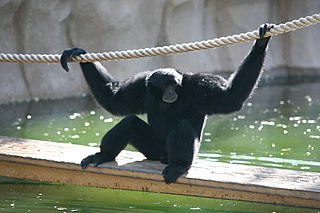 W
WThe siamang is an arboreal, black-furred gibbon native to the forests of Indonesia, Malaysia, and Thailand. The largest of the gibbons, the siamang can be twice the size of other gibbons, reaching 1 m (3.3 ft) in height, and weighing up to 14 kg (31 lb). The siamang is the only species in the genus Symphalangus.
 W
WThe spectral tarsier is a species of tarsier found on the island of Selayar in Indonesia. It is apparently less specialized than the Philippine tarsier or Horsfield's tarsier; for example, it lacks adhesive toes. It is the type species for the genus Tarsius. While its range used to also include the population on nearby southwestern Sulawesi, this population has been reclassified as a separate species, Tarsius fuscus. Some of the earlier research published on Tarsius spectrum refers to the taxon that was recently reclassified and elevated to a separate species, the Gursky's spectral tarsier .
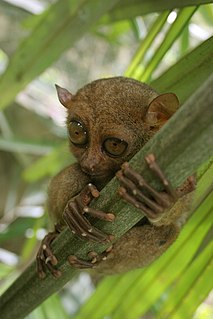 W
WThe Philippine tarsier, known locally as mawumag in Cebuano and other Visayan languages, and magô in Waray, is a species of tarsier endemic to the Philippines. It is found in the southeastern part of the archipelago, particularly on the islands of Bohol, Samar and Leyte It is a member of the approximately 45-million-year-old family Tarsiidae, whose name is derived from its elongated "tarsus" or ankle bone. Formerly a member of the genus Tarsius, it is now listed as the only member of the genus Carlito, a new genus named after the conservationist Carlito Pizarras.